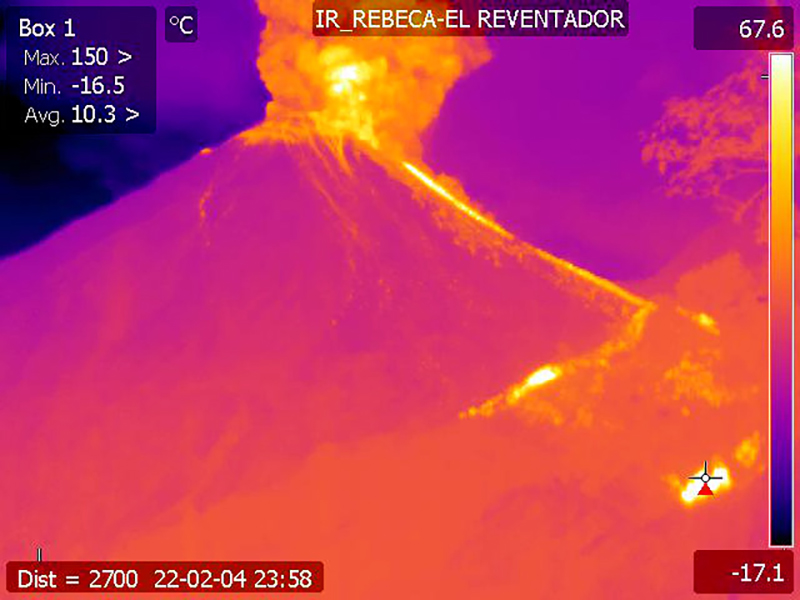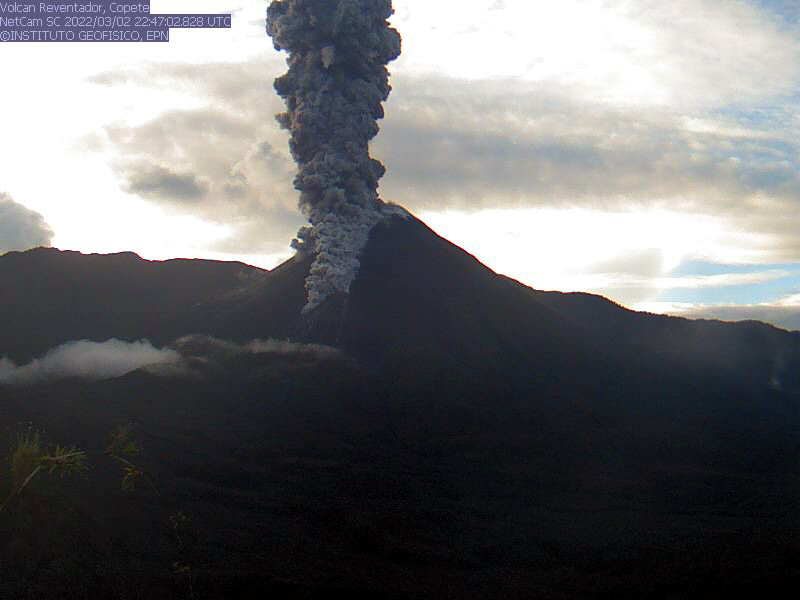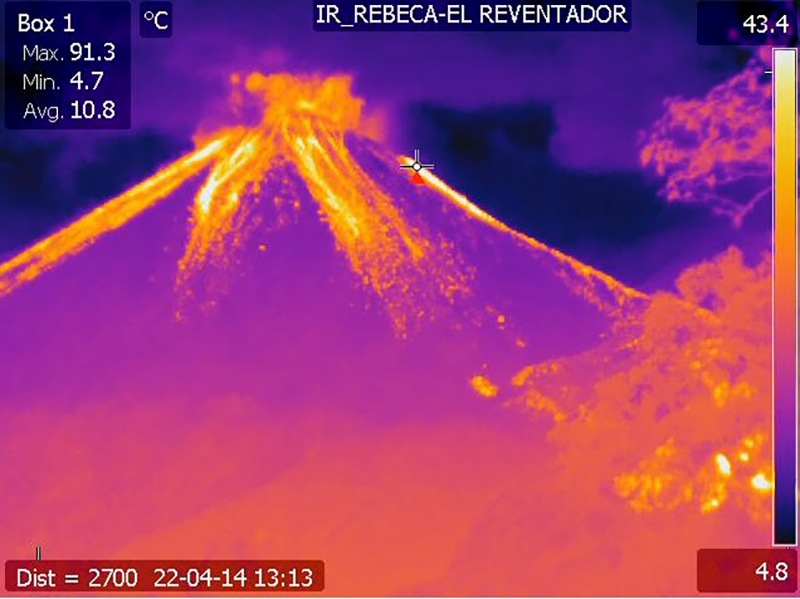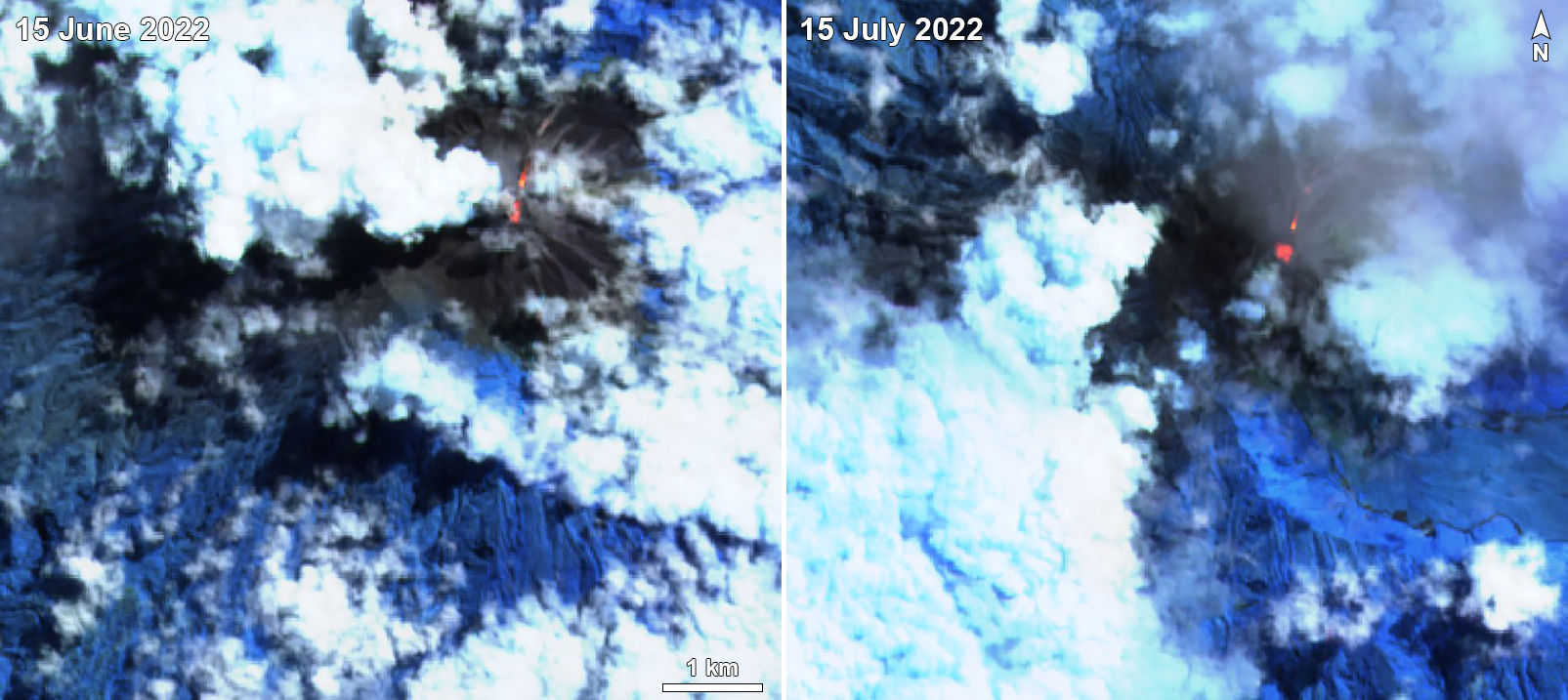Report on Reventador (Ecuador) — September 2022
Bulletin of the Global Volcanism Network, vol. 47, no. 9 (September 2022)
Managing Editor: Benjamin Andrews.
Edited by Kadie L. Bennis.
Reventador (Ecuador) Daily explosions, ash plumes, lava flows, and incandescent block avalanches during February-July 2022
Please cite this report as:
Global Volcanism Program, 2022. Report on Reventador (Ecuador) (Bennis, K.L., and Andrews, B., eds.). Bulletin of the Global Volcanism Network, 47:9. Smithsonian Institution.
Reventador
Ecuador
0.077°S, 77.656°W; summit elev. 3562 m
All times are local (unless otherwise noted)
Volcán El Reventador is located 100 km E of the main axis of active volcanoes in Ecuador, and has dated eruptions extending into the 16th century, characterized by explosive events and lava flows. The current eruption began in late July 2008 and has more recently consisted of daily explosions, ash plumes, incandescent block avalanches, and lava flows (BGVN 47:03). This report covers similar activity during February through July 2022, based on daily reports from Ecuador's Instituto Geofisico (IG-EPN), the Washington Volcano Ash Advisory Center (VAAC), and infrared satellite data.
During February through July 2022, IG-EPN reported daily explosions, gas-and-steam and ash plumes 400-1,900 m above the crater, and frequent crater incandescence, often accompanied by incandescent block avalanches and lava flows. The average number of explosions gradually increased since February, with the highest average numbers of explosions per day in June (57) and July (52) (table 15). At night and early morning, frequent crater incandescence was visible and block avalanches descended all flanks, occasionally accompanied by gas-and-steam and ash emissions. Occasional lava flows were reported traveling down the N, NE, and NW flanks.
Table 15. Monthly summary of explosions and plume heights recorded at Reventador from February through July 2022. Data courtesy of IG-EPN (February-July 2022 daily reports).
| Month | Average number of explosions per day | Max plume height above the crater rim (m) |
| Feb 2022 | 26 | 400-1,300 m |
| Mar 2022 | 29 | 500-1,300 |
| Apr 2022 | 36 | 500-1,600 |
| May 2022 | 36 | 600-1,900 |
| Jun 2022 | 57 | 400-1,900 |
| Jul 2022 | 52 | 500-1,600 |
The summit crater activity was often obscured by clouds during February. There were 4-160 daily explosive events, which generated gas-and-ash plumes that rose 400-1,300 m above the crater and drifted NW, W, SW, S, NE, and SE. Intermittent nighttime crater incandescence was observed in the upper part of the volcano. There were also 14-97 long period (LP) earthquakes and 3-30 emission tremors (signals indicating steam) detected. On 4 February an infrared image showed a lava flow descending the NE flank, which may have started earlier, but was not visible due to cloud coverage (figure 155). During 8-10 February incandescent block avalanches traveled down all flanks as far as 700 m below the crater, in addition to the active lava flow on the NW flank. During 17-18 February an incandescent avalanche of material descended 300 m on the S flank. During 21-22 February the number of daily explosions increased to 160 and 97 LP events were detected. Crater incandescence and the active flow on the NE flank persisted during 28 February-1 March.
Similar activity was reported during March, with 3-68 daily explosions producing gas-and-ash plumes 500-1,300 m high that drifted in various directions. Intermittent nighttime incandescence was observed in the upper part of the volcano, though clouds would often cover clear views of the summit. LP-type events ranged from 23 to 80 and emission tremor events occurred 1-54 times. An incandescent block avalanche was reported during 2-3 March that traveled as far as 500 m down the W flank. A pyroclastic flow on 2 March descended the S and SE flanks (figure 156). On 5 March an incandescent lava flow moved 800 m down the SE flank. During 6-7 March a lava flow was reported on the NE flank and incandescent block avalanches descended the E flank 800 m below the crater. On 8 March the lava flow continued to be active down the NE flank, while at night in thermal images traces of pyroclastic material was visible in the E flank. During the morning of 9 March ashfall was reported by IG personnel. The emitted mass of sulfur dioxide was measured as 18.4 tons by the MOUNTS system on 10 March; during the next day 1,373 tons were detected by the MOUNTS system. At night during 10-11 March, incandescent block avalanches descended all flanks 400 m below the crater. On 24 March a lava flow was identified in a thermal image as it descended the NNE flank.
During April, there were 9-72 daily explosions detected, which generated ash plumes 500-1,600 m above the crater that drifted in multiple directions. LP-type events continued and ranged from 25-87 each day. Emission tremor events occurred 5-59 times each day. Intermittent nighttime and early morning incandescence was also observed in the crater, although occasionally cloud cover prevented clear views of the summit. During 4-5 April incandescent block avalanches were observed descending up to 400 m on all flanks. On 9 April an infrared image showed an active lava flow descending the NE flank. Incandescent block avalanches continued to occur throughout the month, descending multiple flanks (figure 157). During 20-21 April incandescent block avalanches moved 500 m below the summit crater. On 23 April a strong ash plume rose higher than 600 m and drifted NE, NW, and W, according to IG-EPN (figure 158). There was no seismic data recorded during 25-31 April. During the night of 27-28 April incandescent block avalanches descended 400 m down all flanks of the volcano, and the next night descended to 600 m below the summit.
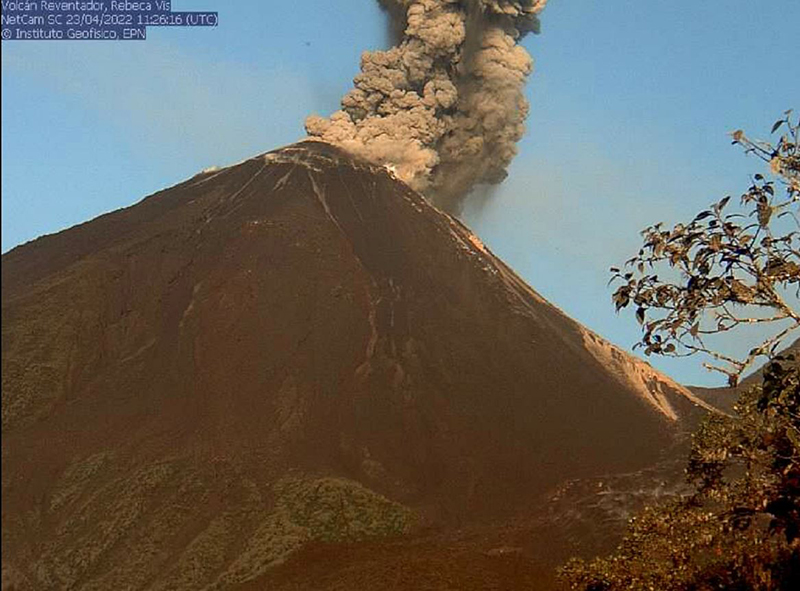 |
Figure 158. Webcam image of a strong ash plume drifting NE from Reventador on 23 April 2022. Courtesy of IG-EPN (INFORME DIARIO DEL VOLCAN REVENTADOR No. 2022-113, 23 de abril de 2022). |
Activity during May consisted of occasional nighttime crater incandescence. There were 10-79 daily explosions detected throughout the month, which produced gas-and-ash plumes that rose 600-1,900 m above the crater and drifted NW, W, NE, N, SW, and S. Intermittent nighttime crater incandescent persisted, though was not always visible due to cloud cover. There were 12-95 LP-type events and 3-25 tremor emission events detected daily. A lahar was detected during 3-4 May due to rainfall. During the night and early morning of 3-7 May incandescent block avalanches descended 400-600 m below the crater on all flanks. On 3 May the MOUNTS system recorded 50 tons of sulfur dioxide emissions. According to the Washington VAAC a gas-and-ash plume rose 1.9 km above the crater and drifted W during 5-6 May. On 9 May a new lava flow was observed in a thermal image that descended 600 m below the crater on the NE flank, which persisted at least through 19 May. IG-EPN reported lahars occurred due to rainfall during 15-16 May. On 29 May a strong ash plume rose 700-1,000 m above the crater and drifted NW (figure 159).
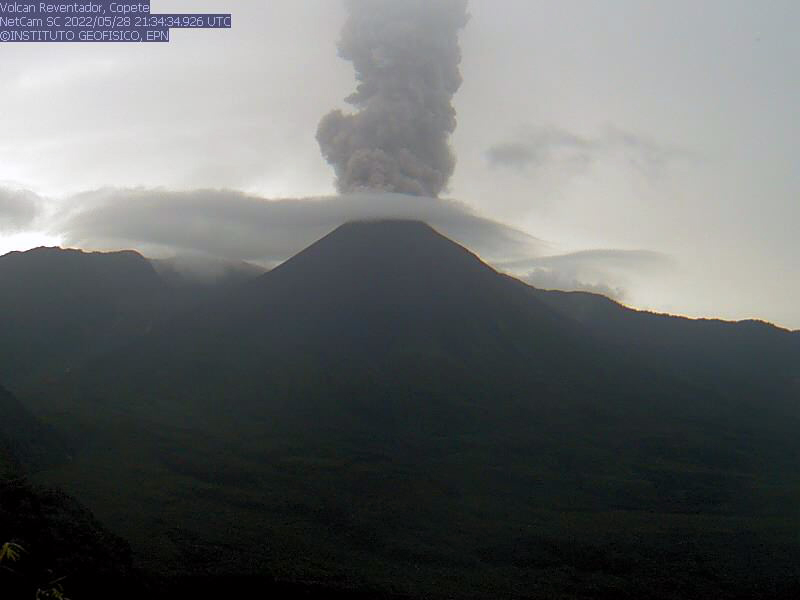 |
Figure 159. Webcam image of a strong ash plume drifting NW from Reventador on 28 May 2022. Courtesy of IG-EPN (INFORME DIARIO DEL VOLCAN REVENTADOR No. 2022-149, 29 de mayo de 2022). |
During June, 11-98 daily explosions produced gas-and-ash plumes that rose 388-1,900 m high and drifted W, SW, NW, NE, N, and SE. LP-type events continued at a rate of 37-102 per day and emission tremor events of 2-35 throughout the month. Nighttime and early morning incandescence was occasionally visible throughout the month, though sometimes clouds covered the summit. On 7 June incandescent material was observed descending all the flanks.
Similar activity persisted during July with 14-105 daily explosions. There were 22-104 LP-type events, and 2-31 emission tremor events detected each day throughout the month. Gas-and-ash plumes rose 500-1,600 m high and drifted W, NW, SW, S, NE (figure 160). Intermittent crater incandescence was reported during the night and early morning. On 1 July, crater incandescence was visible, accompanied by ash emissions up to 700 m high that drifted N on 1 July. Intermittent crater incandescence continued to be visible throughout the month. On 5 July an infrared image showed a new lava flow descending the N flank, which continued the next day down the NE flank. During 7-15 and 28-31 July IGP-EN reported an incandescent block avalanche descending all flanks for 300-600 m below the crater. During 13-14 July an incandescent avalanche descended the S flank and was accompanied by continuous gas-and-steam and ash emissions that rose 900 m high that drifted W. During 21-31 July a lava flow was reported descending the NE flank, though it remained confined to the upper part of the volcano.
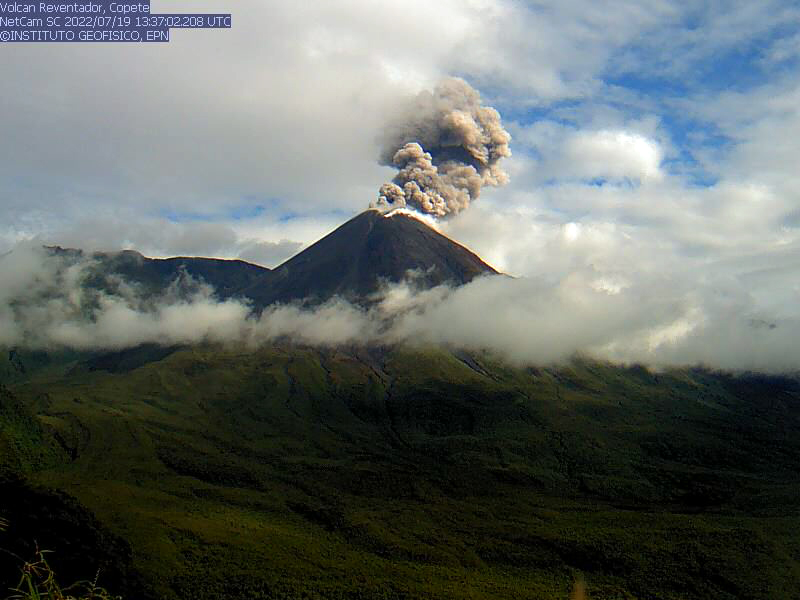 |
Figure 160. Webcam image of a strong ash plume rising from Reventador on 19 July 2022. Courtesy of IG-EPN (INFORME DIARIO DEL VOLCAN REVENTADOR No. 2022-200, 19 de julio de 2022). |
MIROVA (Middle InfraRed Observation of Volcanic Activity) analysis of MODIS satellite data showed intermittent thermal anomalies of varying intensity during February through July 2022, which was most likely represented by incandescent block avalanches and lava flows throughout that time (figure 161). In comparison, 13 thermal anomalies were detected by the MODVOLC thermal algorithm on 18 and 25 March, 10, 21, and 30 May, 6, 9, and 15 June, and 8 and 31 July. Although the summit was often obscured by clouds, Sentinel-2 infrared satellite images showed some of this incandescence at the summit and NE flanks (figure 162).
Geological Summary. Volcán El Reventador is the most frequently active of a chain of Ecuadorian volcanoes in the Cordillera Real, well east of the principal volcanic axis. The forested, dominantly andesitic stratovolcano has 4-km-wide avalanche scarp open to the E formed by edifice collapse. A young, unvegetated, cone rises from the amphitheater floor to a height comparable to the rim. It has been the source of numerous lava flows as well as explosive eruptions visible from Quito, about 90 km ESE. Frequent lahars in this region of heavy rainfall have left extensive deposits on the scarp slope. The largest recorded eruption took place in 2002, producing a 17-km-high eruption column, pyroclastic flows that traveled up to 8 km, and lava flows from summit and flank vents.
Information Contacts: Instituto Geofísico, Escuela Politécnica Nacional (IG-EPN), Casilla 17-01-2759, Quito, Ecuador (URL: http://www.igepn.edu.ec/); Washington Volcanic Ash Advisory Center (VAAC), Satellite Analysis Branch (SAB), NOAA/NESDIS OSPO, NOAA Science Center Room 401, 5200 Auth Rd, Camp Springs, MD 20746, USA (URL: www.ospo.noaa.gov/Products/atmosphere/vaac, archive at: http://www.ssd.noaa.gov/VAAC/archive.html); MIROVA (Middle InfraRed Observation of Volcanic Activity), a collaborative project between the Universities of Turin and Florence (Italy) supported by the Centre for Volcanic Risk of the Italian Civil Protection Department (URL: http://www.mirovaweb.it/); Hawai'i Institute of Geophysics and Planetology (HIGP) - MODVOLC Thermal Alerts System, School of Ocean and Earth Science and Technology (SOEST), Univ. of Hawai'i, 2525 Correa Road, Honolulu, HI 96822, USA (URL: http://modis.higp.hawaii.edu/); Sentinel Hub Playground (URL: https://www.sentinel-hub.com/explore/sentinel-playground).


